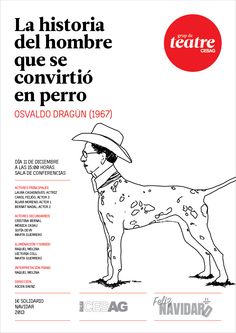6.2 El hombre que se convirtió en perro – Osvaldo Dragún
7 min read•june 18, 2024
AP Spanish Literature 💃🏽
24 resourcesSee Units
The literary work, El hombre que se convirtió en perro, discusses themes of identity, conformity, and the dehumanizing effects of some occupations.
📖 Context of El hombre que se convirtió en perro
👨 Author Background
Osvaldo Dragún was born in Buenos Aires, Argentina, in 1926. He studied literature at the University of Buenos Aires, where he became involved in the avant-garde literary movement of the 1940s and 50s. He was and remains well-known for his satirical and politically charged works that frequently criticized society and power systems.

Image Courtesy of Genius
Time and Place
📜 Historical: The play was created in the middle of the 20th century, when Argentina was experiencing political unrest and social transformation. The "Theater of the Absurd," a larger literary trend in Latin America, which was born out of the existential crises and disillusionment that followed World War II. This play is a part of that literary trend.
🗺️ Geographic: The story is set in an urban environment that probably represents a typical city in Argentina. Although the precise location is not specified, the urban setting supports the protagonist's struggle and mirrors the industrialization and modernization that were occurring in Latin American cities at the time.
Societal Atmosphere
👑 Political: Argentina experienced periods of political repression and military dictatorship in the middle of the 20th century. The play's themes of conformity, dehumanization, and the battle of the individual against repressive systems are most likely strong reflections of those situations.
🧑🏽🤝🧑🏻Socioeconomic: The socioeconomic setting of the narrative captures the difficulties faced by Argentina's working class as well as the results of economic inequality. The protagonist's desperation for work and acceptance of a humiliating position reflect the difficulties that many people in that era experienced, when getting employment was challenging and frequently required sacrificing one's dignity.
🎭 Cultural: The importance of labor, the challenges of the working class, and the discovery of identity are only a few examples of how the play captures aspects of Argentina's culture and society at the time. Additionally, this play uses universal human ideas and experiences that cut through particular cultural barriers.
Need to Know About El hombre que se convirtió en perro
The players discussing the play, the man who transforms into a dog, and his wife are the play's characters. The performers take on the roles of the story's narrators and watchers, adding commentary and thinking back on what happened. The husband is a metaphor for the struggle of individuals in a dehumanizing and conformist society, and his wife is a representation of the comfort and support he receives in the face of difficulties. The investigation of identity, societal expectations, and the human experience in the face of difficulty are all aided by the characters.

Image Courtesy of Kayla Scheer
🤔 Characters
The main character, a man who plays the role of a dog (but does not transform or physically and biologically become a dog) highlights the battle to maintain one's humanity in a repressive society by representing the dehumanization and loss of personal identity suffered by individuals confined to tedious and demeaning tasks.
Though not the major subject, the man's wife provides moral support and compassion, exemplifying the fortitude and power of people who face social pressures and work to uphold their humanity in trying situations.
The play's actors (actors 1, 2, and 3) serve as a collective voice that questions and critiques social norms and expectations by engaging in dialogue that blurs the boundaries between fiction and reality.
The employer, although not a prominent figure, represents the repressive power structures and the degrading impacts of some occupations. This reflects the domination and control over people in certain societies.
🧠 Literary Terms and Devices
Some literary terms and devices that you should be familiar with for this text include:
- Personaje (Character): The well-developed characters in the literary work individually contribute to the investigation of identity and societal expectations. Examples are the performers who provide insight throughout the play, the man who transforms into a dog, and his wife who wants to provide support.
- Ambiente (Setting): The urban location of the literary work mirrors the industrialization and urbanization of Latin American cities at the period. This sets the stage for the protagonist's problems and highlights the uncomfortable nature of some occupations.
- Stage directions, or acotación, are used throughout the play to give instructions for the performers' postures, facial expressions, and hand gestures. This improves the theatrical experience and adds to the overall interpretation and execution of the work.
- Público (Audience): Although it isn't stated directly, the literary work acknowledges the audience's presence through the dialogue between the players, introducing a meta-theatrical element and merging the worlds of fiction and reality.
- Irony is used in the literary work to show the absurdity and contradictions that exist in society. For example, the man changing into a dog is a metaphor for the dehumanization that people who fill particular societal roles endure.
- Satire: Using satire, the literary work exposes the flaws and absurdities of the social order by criticizing and making fun of established standards, power structures, and the conformity expected of individuals.
- Hipérbole (Hyperbole): In the literary work, hyperbole is utilized to emphasize particular details, such as the man's transformation into a dog, accentuating the dehumanizing effects of his work and the social constraints he must deal with.
- Dialogue is an important part of the literary work since it enables character interaction and the sharing of thoughts, viewpoints, and feelings while also allowing for the study of themes and the progression of the story.
🔍 Summary of El hombre que se convirtió en perro
The satirical drama El hombre que se convirtió en perro represents the urbanization and industrialization of Latin American cities at the time it was written. In an imaginative transformation, the main character takes on the role of a dog and acts out this role as a job, which metaphorically depicts the dehumanization felt by those who are forced into particular societal positions.
The play dives into the complexities of identity and the limitations of conformity within a societal framework. This is done through the clever use of dialogue and stage directions. The dialogue between the characters explores the fight against repressive structures and highlights the absurdity and contradictions that are rooted in the social order. A critique of the devaluation of human existence within specific societal duties is provided by the man's portrayal of dog as his job.
The play asks the audience to consider the expectations that society places on people as the story develops. It highlights the limits on personal freedom and the degrading impacts of conformity. The play exposes the flaws and hypocrisy of the social order through irony and satire, provoking the audience to think about the absurdity of established conventions and power structures.
This play acts as a reminder of how important it is to keep one's individuality and fight off pressure from a conformist culture. Discussions about the need for change and the quest for a more compassionate and equitable world are sparked by the play's incisive social satire, which encourages the audience to reconsider their own roles and responsibilities within the larger societal context.
🔗 Themes in El hombre que se convirtió en perro
These are themes you should be prepared to relate back to the story for the AP test!
Las sociedades en contacto (Societies in contact)
This theme is indirectly addressed in the literary work by showing interactions between various social roles, such as actors and a man who transforms into a dog, and highlighting the conflicts, power dynamics, and difficulties that emerge when various social groups come into contact.
Las divisiones socioeconómicas (Socioeconomic divisions)
The literary work explores this theme through the protagonist's struggle for employment and acceptance of a demeaning job. This highlights the economic disparities and social divisions that exist in society and the limitations that people from lower socioeconomic backgrounds frequently face.
Las relaciones familiares (Family relationships)
Family relationships are discussed through the presence of the man's wife, who provides comfort and support in the face of his difficulties. This deepens the emotional connection and illustrates how strong family ties can be in the face of hardship.
Las relaciones de poder (Power Relationships)
This piece examines power dynamics through critiquing cultural norms and structures that promote compliance and dehumanization. It also exposes the inequities and difficulties in power relations. This emphasizes the power dynamics between employers and employees, the pressures of society norms, and the fight against oppressive systems.
🌟 Significance of El hombre que se convirtió en perro
The impact of El hombre que se convirtió en perro on modern culture is still felt present today. In a time of rising social inequality and the fight for the inclusion of underrepresented voices, the examination of societal norms and power structures this piece is very applicable.
The play places significance on the value of human life and loss of individual agency. People frequently find themselves imprisoned in demeaning employment or societal responsibilities and this play makes people reflect on those actions. Through this play, people are able to see the contradictions of society and some of the absurd demands it has.
In addition, "The Story of the Man Who Turned into a Dog" encourages us to consider the effects of interacting societies and the effects of socioeconomic inequality. It emphasizes the difficulties faced by people trapped between opposing cultural, economic, and social demands. By doing this, the play encourages debate about the value of inclusivity and social justice in modern society and promotes empathy and understanding.
The play's examination of power relationships and family dynamics also sheds light on the complexities of human relationships. It serves as a reminder of the value of healthy family relations and open communication.
The one-act play is significant for its exploration of identity, alienation, transformation, and the power of belief. It is an experimental work that sought to challenge traditional literary conventions and explore deeper questions about the nature of reality.
Always remember that he took on this role. He did not physically or biologically become a dog but rather, he acted as one.
Browse Study Guides By Unit
🏇Unit 1 – La época medieval
🛳Unit 2 – El siglo XVI
🖌Unit 3 – El siglo XVII
🎨Unit 4 – La literatura romántica, realista y naturalista
🤺Unit 5 – La Generación del 98 y el Modernismo
🎭Unit 6 – Teatro y poesía del siglo XX
🌎Unit 7 – El Boom latinoamericano
🗣Unit 8 – Escritores contemporáneos de Estados Unidos, y España

Fiveable
Resources
© 2025 Fiveable Inc. All rights reserved.